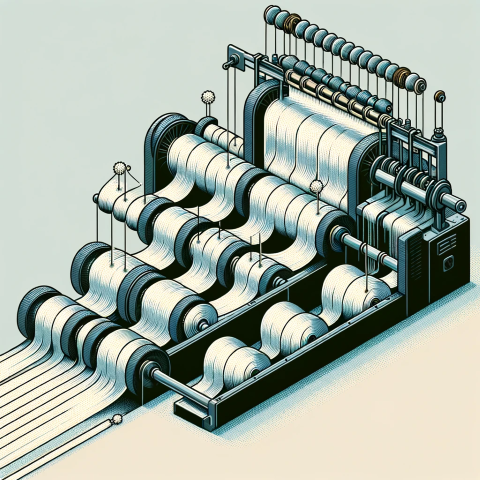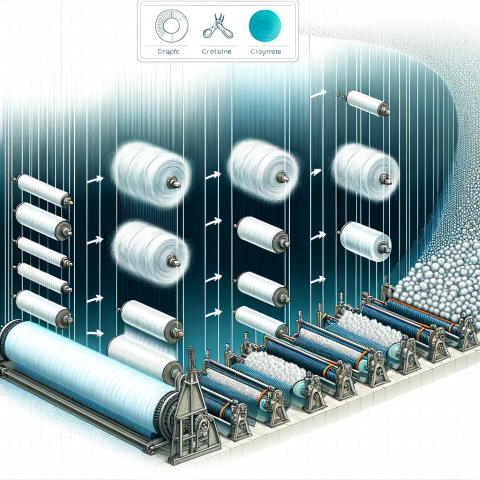Last Updated on: 31-Mar-2024 (3 months, 27 days ago)
Share on Facebook • Share on Twitter
Mastering Drafting Techniques: A Journey into Fiber Innovation
Drafting in Textile: Exploring the Art of Fiber Formation
In the textile industry, drafting refers to the process of attenuating or reducing the thickness of fibers to create yarns of desired fineness and strength. This critical step in textile production determines the quality and properties of the final fabric. This article provides a comprehensive understanding of drafting, including its history, types, tips for handling, and profiles of top international users and manufacturers.
The art of drafting can be traced back to ancient civilizations where hand spinning and fiber manipulation techniques were practiced. Historically, manual drafting involved stretching fibers and pulling them apart to create thinner strands. With the advent of industrialization, mechanized drafting machines were developed, revolutionizing textile manufacturing. Today, modern drafting machines employ advanced technologies to ensure precise and consistent fiber attenuation.
Drafting techniques vary depending on the desired yarn characteristics and the type of fibers being processed. Some common types of drafting methods include:
- Simplex Drafting: Simplex drafting is a widely used method where the fibers pass through a series of pairs of drafting rollers. The rollers rotate at different speeds, creating tension and elongating the fibers to reduce their thickness.
- Roving Drafting: Roving drafting is employed in the production of roving yarns, which are thicker than regular spun yarns. It involves attenuating fibers further after the simplex drafting stage, typically using a spinning frame or ring frame.
- Combing Drafting: Combing drafting is used for long-staple fibers such as wool or worsted. The process involves combing and aligning the fibers before passing them through drafting rollers for further reduction in thickness.
- Compact Drafting: Compact drafting is a modern technique that reduces fiber slippage during the drafting process. It involves the use of a compacting device that compresses the fibers to prevent air entrapment and enhance yarn strength.
Tips for Handling Drafting Process
Handling the drafting process requires careful attention to ensure optimal yarn quality:
- Proper Machine Setup: Calibrate and set up the drafting machine accurately, including roller gaps and speeds, to achieve consistent and uniform fiber attenuation.
- Fiber Preparation: Ensure fibers are properly prepared, cleaned, and aligned before feeding them into the drafting machine to prevent clogging or uneven drafting.
- Tension Control: Monitor and adjust the tension levels during drafting to maintain a balance between fiber strength and fineness.
- Regular Maintenance: Conduct routine maintenance and cleaning of drafting machines to prevent build-up, reduce downtime, and ensure optimal performance.
Top International Users and Manufacturers
Several prominent companies specialize in drafting technology and serve as global leaders in the textile industry:
- Itema Group: A leading provider of advanced weaving solutions, Itema Group offers innovative drafting systems for the production of high-quality fabrics.
- Trtzschler Group: Trtzschler Group excels in manufacturing textile machinery, including drafting systems, renowned for their precision and efficiency.
- Rieter: Rieter is a prominent supplier of systems for short-staple fiber spinning, offering drafting solutions that optimize productivity and yarn quality.
- Marzoli: Marzoli specializes in designing and manufacturing spinning machinery, including drafting systems, known for their reliability and performance.
- Suessen: Suessen is a leading provider of drafting components and systems, offering innovative solutions to enhance the spinning process.
Drafting plays a pivotal role in textile production, allowing the transformation of fibers into yarns with desired characteristics. From ancient manual techniques to modern, highly precise machinery, the art of drafting continues to evolve, driving innovation and excellence in the textile industry. Understanding the history, types, and tips for handling drafting processes provides valuable insights into the intricate world of fiber formation, enabling textile professionals to push boundaries and create fabrics of exceptional quality and performance.
�Fashion Designing:
Drafting is an important process in textile manufacturing that involves creating a pattern for a garment or other textile product. The process involves taking measurements of the body or other object that the textile product will be worn or used on, and then creating a precise pattern that can be used to cut and sew the fabric into the desired shape.
The drafting process typically involves several steps. First, the measurements of the body or object are taken using a variety of tools, such as a measuring tape or a body scanner. These measurements are then used to create a basic pattern, which is typically drawn on paper using specialized drafting tools such as a ruler and a compass.
Once the basic pattern has been created, it is then refined and adjusted to ensure a perfect fit. This may involve adding or subtracting material in certain areas, adjusting the placement of darts or other shaping elements, or making other modifications to the pattern as needed.
Drafting is an important process in textile manufacturing because it ensures that each garment or other textile product is made to a precise size and shape. This is particularly important in the fashion industry, where fit and appearance are key factors in determining the success of a particular garment or collection.
In addition to ensuring a proper fit, drafting can also help to improve the overall appearance and functionality of a textile product. For example, a garment that has been properly drafted will drape correctly and move with the wearer, creating a more comfortable and stylish look. Similarly, a textile product that has been properly drafted for a specific purpose, such as a backpack or a tent, will be more functional and effective in its intended use.
Drafting can be done by hand using traditional drafting tools, or it can be done using computer software. Computer-aided drafting (CAD) has become increasingly popular in recent years, as it allows designers to create precise and detailed patterns quickly and easily. CAD software can also be used to create virtual prototypes of textile products, allowing designers to test and refine their designs before creating physical samples.
In conclusion, drafting is an essential process in textile manufacturing that involves creating a precise pattern for a garment or other textile product. The process ensures a proper fit, improves the appearance and functionality of the product, and can be done by hand or using computer software. Whether you're designing a new fashion collection or creating a specialized textile product for a specific application, drafting is a critical step in the manufacturing process that should not be overlooked.
Some more terms:
Bleeding
In the textile industry, "bleeding" refers to the phenomenon where dyes or pigments used to color fabrics leach out or migrate from the fabric when exposed to moisture, such as water or sweat. This...
Read about BleedingExploring Air Jet Loom: A Textile Industry Game-Changer
The Evolution and Impact of Air Jet Looms in the Textile IndustryThe inception of air jet looms marks a significant chapter in the textile industry, revolutionizing fabric production. Emerging in the...
Read about Air Jet LoomsLayering
Layering involves the use of a comfort or base layer; an insulation layer; and a protection layer. The base layer comprises clothing worn next to the skin. Perspiration drying on the skin can cause...
Read about LayeringBathrobe
A robe is a loose-fitting outer garment of various types, including: * A gown worn as part of the academic dress of faculty or students, especially for ceremonial occasions, such as a convocations or...
Read about BathrobeConvertible Collar
A convertible collar is a distinctive type of collar used in clothing, particularly in garments like shirts, blouses, and jackets. It is characterized by its versatile design, which allows it to be...
Read about Convertible CollarLoom state
Loom state is a term commonly used in the textile industry to describe the condition of a fabric immediately after it is woven on a loom but before any finishing processes have been applied. It...
Read about Loom stateLambswool
This is the wool that is taken from sheep before they reach the age of 7 months. It is soft, slippery, resilient and smooth and has superior spinning properties. It is used in fine grade woolen...
Read about LambswoolHairline
In the textile industry, the term "hairline" refers to a specific type of fabric pattern or finish that resembles the fine, delicate hairs on the surface of certain materials. It is characterized by...
Read about HairlineOn this page
Add a definition
- The term you want to define
- Its definition in 500 words or less
- Attach an image if necessary.
- Optionally, tell us about yourself in 200 words or less!
Companies for Drafting:
- Company name
- Company address
- Attach a logo, if necessary.
- Optionally, tell us about yourself in 200 words or less!

 Fashion designer Payal Singhal launched her first collection at the age of 15.
Fashion designer Payal Singhal launched her first collection at the age of 15.

